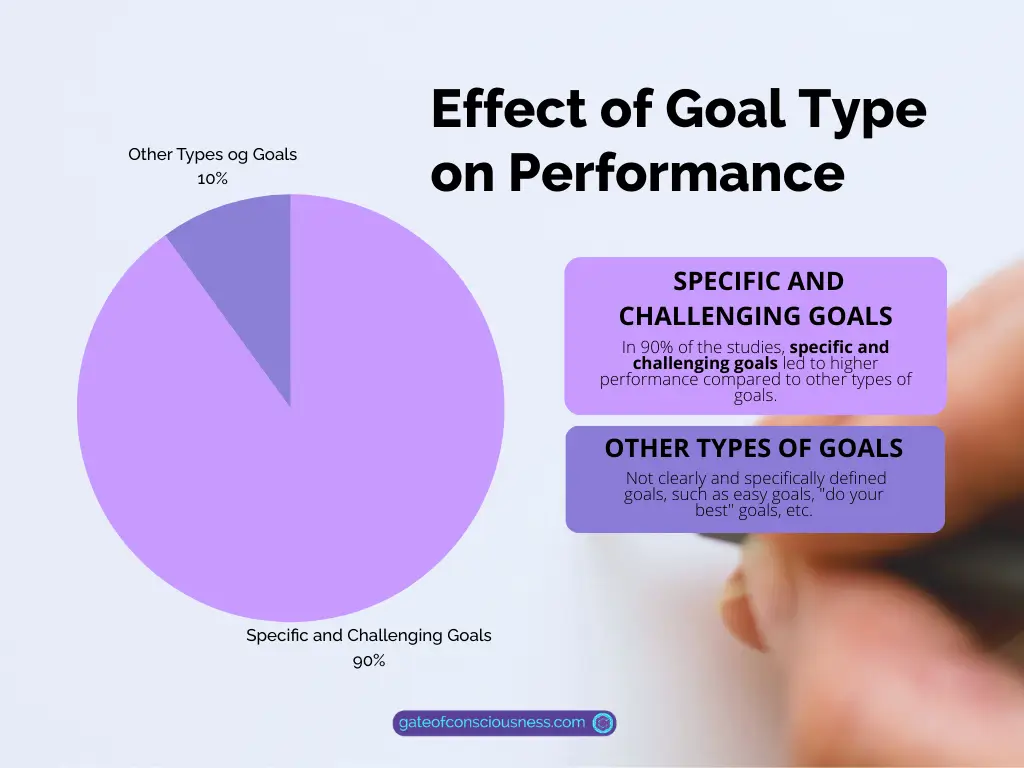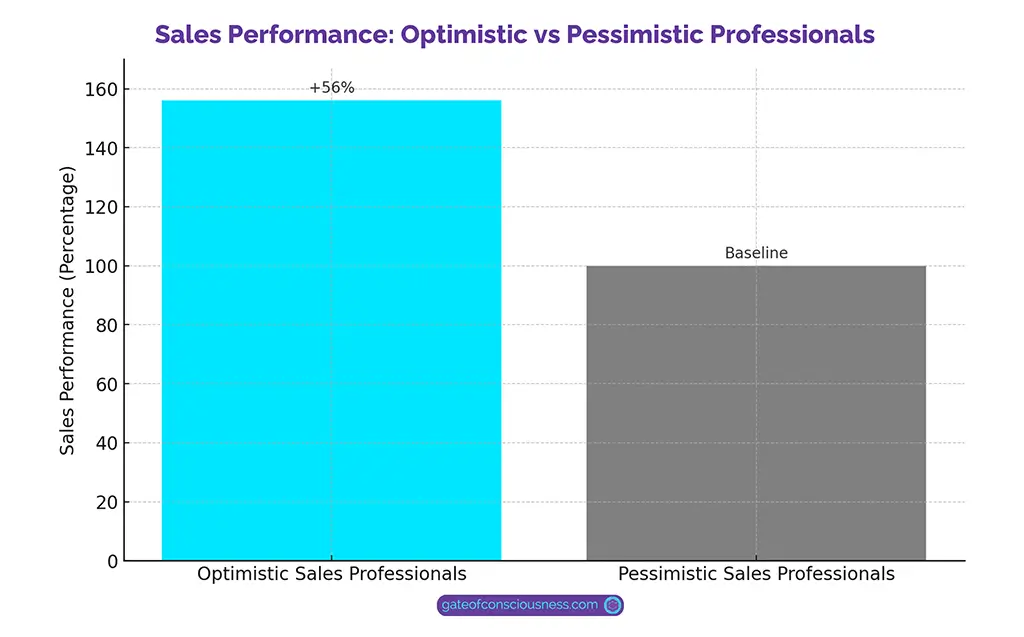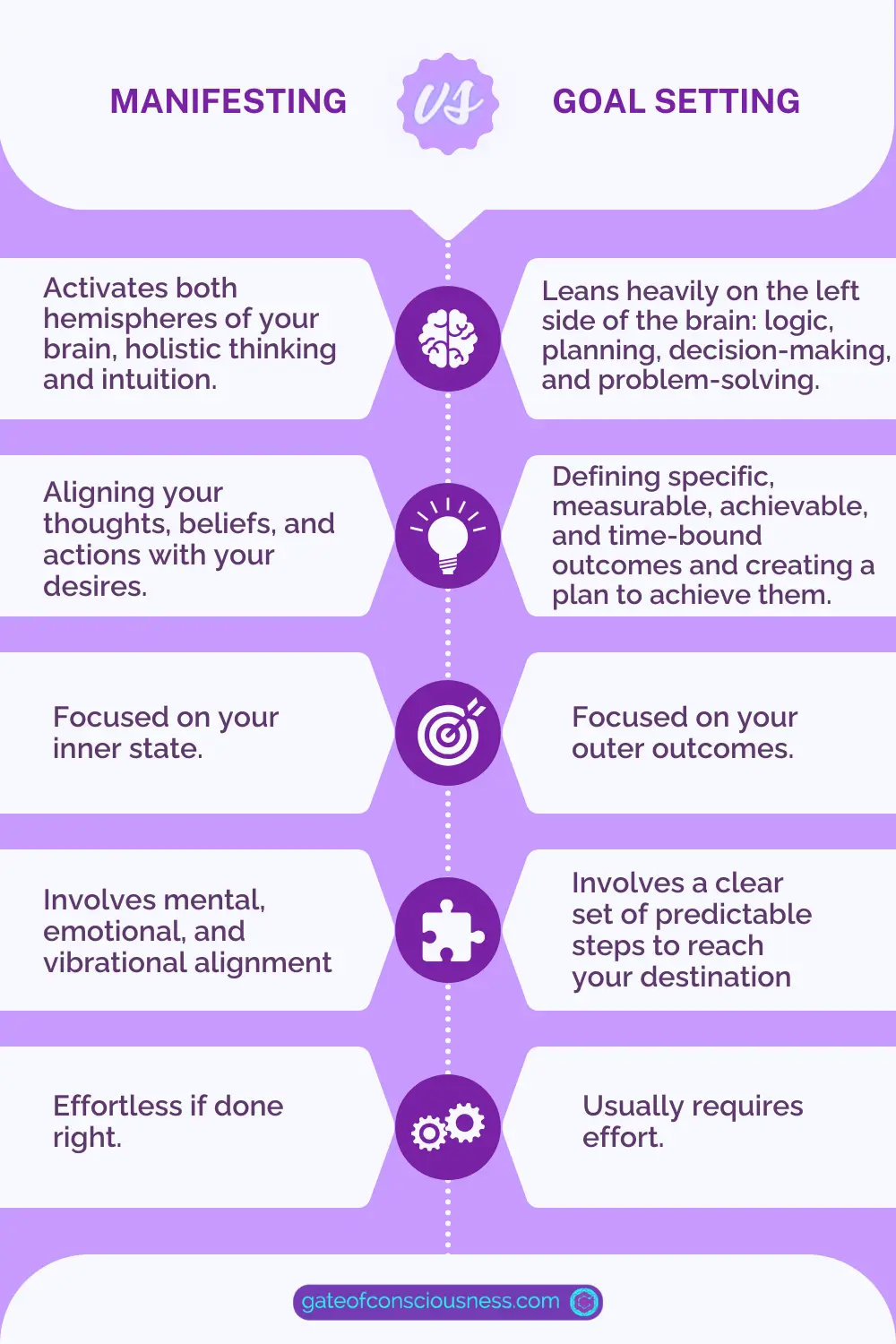Manifesting vs Goal Setting: Which Is Better For Successful Manifestation?
Why do some people seem to effortlessly attract success while others grind tirelessly with little to show for it? The secret might just lie in understanding the difference between manifesting and goal setting. In this blog post, we will discuss manifesting vs goal setting and how they compare.
Manifesting vs Goal Setting: Definitions
When it comes to achieving our dreams, we often hear two terms thrown around: manifesting and goal setting. But what sets them apart?
Before we can answer that, we need to be on the same page about what these two terms mean.
According to the Cambridge Dictionary:
Goal Setting means deciding what you want to achieve or what you want someone else to achieve in a certain time frame.
Manifesting means making something happen by imagining it and consciously thinking that it will happen.
Okay, now, when that’s out of the way, we can dive into their differences.
Manifesting vs Goal Setting: What’s the Difference?
Manifesting differs from traditional goal setting in several ways.
These are the 5 key differences:
| GOAL SETTING | MANIFESTATION | |
| Main objective | Taking action | Embodying state of being |
| Orientation | Future-oriented | Present-oriented |
| Focus | External outcomes | Inner states |
| Realm of | Predictability | Possibility |
| Effort | Usually requires effort | Effortless if done right |
Goal Setting
With goal setting, you are achieving your goals with your actions. It’s based on the idea that you can achieve what you want by breaking it down into manageable steps and following them consistently. It is like plotting a course with a GPS.
The main objective is to take action that helps you achieve your goal. You know exactly what steps to take to achieve success.
Goal setting is logical, focused on outcomes, and involves a clear set of predictable steps to reach your destination.
You are defining and measuring the results that you want to achieve and tracking your performance and feedback.
There are many benefits of having a system to measure and track your goals. This is an essential element of my approach to manifesting.
Goal-Setting Example:
Let’s say you want to buy a house. In that case, your goal-setting statement should include the following parameters:
- Size: How big should your home be?
- Location: Specify the area or neighborhood where you want to buy the home.
- Budget: Define your budget range for the purchase.
- Timeframe: What is the exact date by which you will own it?
- Action Steps: Include steps like saving a certain amount each month, getting pre-approved for a mortgage, or working with a real estate agent.
For example:
“I plan to buy a 3000 sq ft home in [desired neighborhood], within a budget of [x amount], by the end of next year, and will save [y amount] every month towards the down payment.”
You know where you’re headed and how you’ll get there, step by step.
Manifesting
Manifesting is based on the premise that your thoughts have the power to influence reality. It is more like setting a compass direction and allowing the wind to guide your sails.
The main objective is the embodiment of the state of being of the person who already has your desire.
Here’s what I mean by embodiment:
To create wealth in your life, you have to get familiar with what wealth feels like in your mind and body. You have to become comfortable with it. The same goes for love, health, and everything else – it has to become your new normal.
This is often called living in the end.
With manifesting, you’re getting clear on what you want and aligning your mindset and energy to attract it towards you. It’s not about the physical.
There is no forcing or controlling the external world but rather aligning yourself with the natural flow of the universe.
You’re tapping into the power of your subconscious, focusing not just on the destination but on the journey and your state of being. It’s about emotional and vibrational alignment.
Manifestation techniques like visualization, affirmations, scripting, and similar methods can help you achieve that.
You are not attaching yourself to a specific result. You’re embodying the state of being that you want to experience.
This holistic approach makes manifesting a powerful tool, especially when traditional goal-setting methods fall short.
Manifesting Goal Example:
Typically, manifesting focuses more on the feeling and the end state than the specific details.
Let’s stick with the example of buying a home:
In your goal statement, you need to include more about how owning this home will make you feel or the qualities of your ideal home.
Basically, you need to describe an event that implies that your house is already yours or on its way to you. For instance:
- “I am attracting a spacious and comfortable home that feels perfect for my family and me.”
- “I have a beautiful home that provides a sense of peace and happiness to my family.”
A manifesting goal often includes past or present tense language and emotional words to align your subconscious with the desired outcome.
Manifesting vs Goal Setting: Comparison Table
| Manifesting | Goal Setting | |
|---|---|---|
| Common examples |
|
|
| Benefits |
|
|
| Requirements |
|
|
Why Goal Setting Doesn’t Always Work
Goal setting may not work for several reasons. For instance, it may lead you to believe that your desires are possible only if certain external benchmarks are achieved. It can also foster a mindset of scarcity, drawing attention to what is absent from your life rather than what you already have.
Why Manifestation Doesn’t Always Work
The most common reasons why manifestation doesn’t work are lack of clarity or lack of belief in the desired outcome. Successful manifestation requires crystal clarity and persistent focus. Having subconscious blocks or conflicting desires can also prevent your manifestation.
The Science Behind Manifesting and Goal Setting
Did you know that your brain has built-in mechanisms for achieving goals and manifesting desires?
The principles of directed thoughts, unrelenting desire, belief power, and persistent action are not just spiritual concepts but are backed by neuroscience and psychology.
Prefrontal Cortex
Goal setting activates the prefrontal cortex (PFC). It is the part of the brain responsible for planning, decision-making, and problem-solving.
The PFC helps you set goals, prioritize tasks, monitor progress, and adjust your strategy. By setting SMART goals and writing them down, you are engaging your PFC to focus on your desired outcome and find the best way to achieve it.
Setting goals does more than just give us direction; it also activates our brain’s reward system. Achieving even small goals triggers a release of dopamine, endorphins, and oxytocin, providing a neurochemical boost that stimulates us to achieve more.
The manifestation process works in the brain by activating the reticular activating system (RAS).
The reticular activating system (RAS) is a network of neurons that filters the information that reaches your conscious awareness. The RAS acts like a magnet, drawing your attention to what is relevant and important to you and filtering out what is not.
This is why being clear about what you want is so crucial – the more specific your goal, the more effectively your RAS can guide you towards it.
By setting clear intentions and visualizing them with emotion and detail, you are programming your RAS to look for opportunities and resources that match your desired outcome.

Why Does Goal Setting Matter?
Setting clear and specific goals plays a crucial role in achieving your goals. According to a study in Psychological Bulletin, people are more likely to persist and stay motivated if their goal is specific and challenging.
In this context, challenging goals are those goals that stretch our capabilities.
This research indicates that setting specific and challenging goals leads to higher performance in 90% of studies. In contrast, other types of goals, such as easy goals, “do your best” goals, or having no goals at all, are much less effective.

Backing of Manifestation
A lot of people dismiss manifestation as mere wishful thinking.
The problem lies in the oversimplification of the manifestation process and the law of attraction.
Manifestation is much more complex than it meets the eye. It includes reprogramming the subconscious mind so that you become the person who has your desire. This includes changing your perception to be more receptive to what you want and to positivity in general.
Now, you might say that having a positive attitude doesn’t actually affect the outcomes. However, there are many studies out there that prove how our attitudes and expectations shape our reality.
For instance, this study found that optimistic salespeople outsell their pessimistic peers by 56%. As a result of this study done at MetLife, the insurance company started hiring people based on their level of optimism. This move helped them keep their employees longer and save millions of dollars. So, apparently, positive thinking does pay off.

Of course, there is also a metaphysical component to manifestation that we won’t get into in this post. You can read about it in previous posts.
How to Use Manifesting and Goal Setting Together to Insure Success
As you can see, manifesting and goal setting are not opposites but rather different stages of the successful manifestation process.
As mentioned, setting goals is essential in the way I use and teach manifestation. Without it, it’s much more challenging to persist in what you want.
Step-By-Step Process
Start With the Basic Manifesting Approach:
Before you set any goals, start by imagining what you want. You can also journal about it: Who is the version of you who has your desire? What does she think? How does she feel? This will help you set intentions that guide you in the right direction and prime your brain for the next steps.
Follow With Goal Setting:
Even people who think they know what they want tend to set lousy goals. Your goals should be specific, measurable, and believable to you. Ask yourself: How will I know that I have achieved my goal? How will I track my progress? Do I truly believe that my goal is possible, or do I need to work on my belief system, too? Write it all down with clarity and detail.
Create a Plan:
Remember that your job is to embody the state of being the person who has what you want. So, create a plan that supports that vision. Basically, you need to get into that state mentality and emotionally. Then, reverse-engineer the process of getting there. This might require that you change some habits. But once your subconscious embodies the new identity, you will do it automatically. Track your progress and feedback, and adjust your strategy as needed.
Feel as if You Already Have It:
Regularly visualize your desired outcome with emotion and detail. Express your gratitude and appreciation for what you have and what’s coming. This engages your RAS and attracts more opportunities and resources that match your intentions.

Infographic Manifesting vs Goal Setting
Manifesting vs Goal Setting: Conclusion
Manifesting and goal setting are similar approaches that can help you create your physical reality the way you want. They are not opposites but rather two sides of the same coin.
They have different strengths and weaknesses and suit different situations and scenarios. For best results, you should use them together. They enhance each other and create a synergy that is greater than the sum of its parts.
The key is to start with manifesting, follow with goal setting, balance both approaches, and experiment.
Don’t forget to have fun, too!






